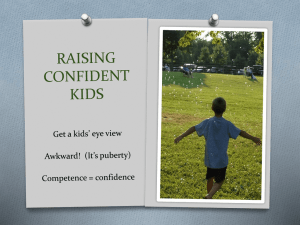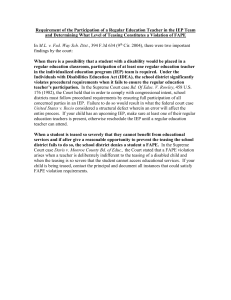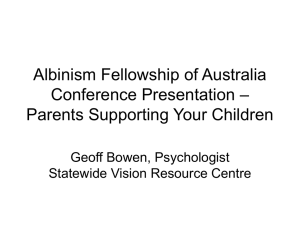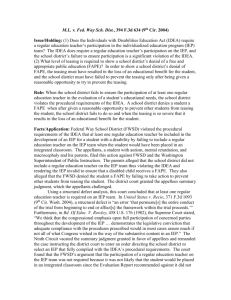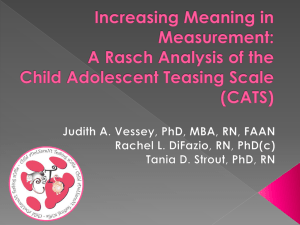Running head: TEASING SYSTEMS OF ROMANTIC RELATIONSHIPs
advertisement
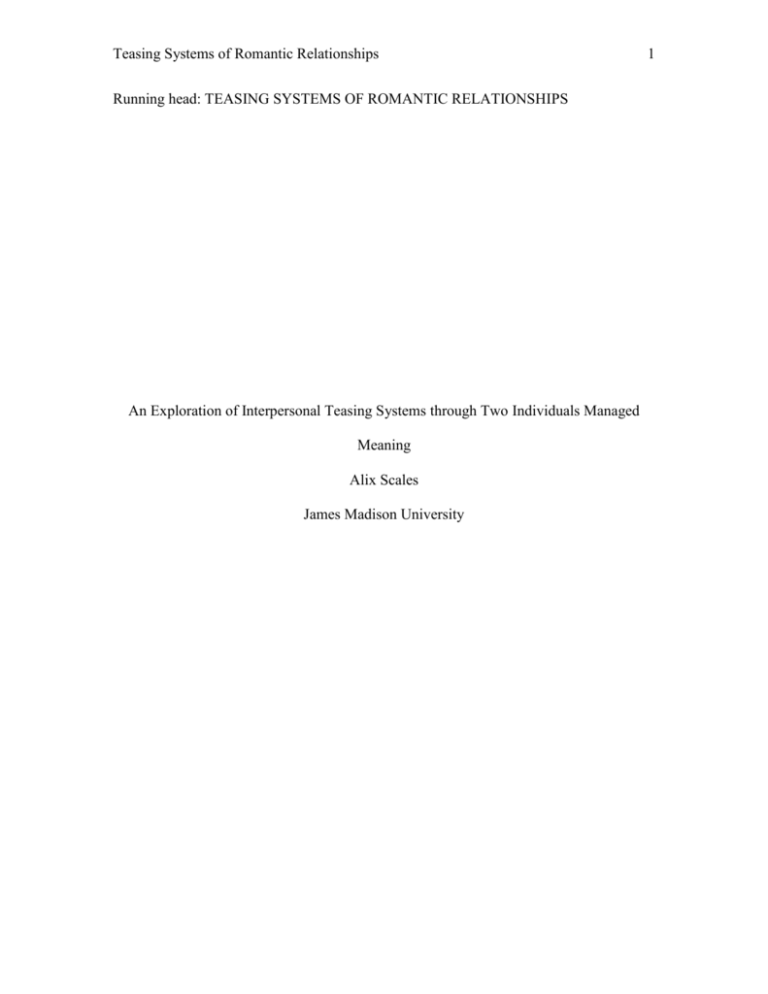
Teasing Systems of Romantic Relationships Running head: TEASING SYSTEMS OF ROMANTIC RELATIONSHIPS An Exploration of Interpersonal Teasing Systems through Two Individuals Managed Meaning Alix Scales James Madison University 1 Teasing Systems of Romantic Relationships 2 Abstract The process of teasing is an integral and almost inseparable part of interpersonal relationships. One of the things that marks intimacy with a person is the ability to tease and be teased by them. As romantic couples engage in relationships, their teasing interactions take on a logical force that includes each person, but also constructs a relationship which is greater than the sum of both individuals. Previous research has focused on studying the effects of teasing primarily with children, college-aged adults, married couples, and those in the workplace. Previous research has also studied how teasing acts affect the relational quality between the interactants, but has left a research gap for the teasing acts of college-aged romantic couples. There is also a research gap in examining how people come to the point of utilizing a teasing speech act, and in looking at teasing as a way in which couples can express and reconstruct their relationship. This research will examine how two individuals interact with each other through teasing. Different teasing acts will be qualitatively evaluated to learn about their communication patterns. This will describe and evaluate the factors that make these teasing acts either constructive or destructive. This research will evaluate the nature of teasing, and suggest how people might be able to improve their relationships by avoiding negative teasing and choosing to foster relationships that use positive teasing. Although this was the goal at the start of the project, the research method that I used encompassed much more than just teasing. It eventually turned into an organic learning process, which prohibited me from focusing on teasing, because if I did, the overarching coordinated meaning and system of the entire interaction would have been Teasing Systems of Romantic Relationships lost. Therefore the research had to adapt to these changes which greatly altered the structure of the intended research project into something very uncharacteristic of a traditional project. 3 Teasing Systems of Romantic Relationships 4 An Exploration of Interpersonal Teasing systems through two individuals Managed Meaning The field of interpersonal relationships is very large and highly researched. The way that one individual interacts with others not only affects that particular individual at that one time in that one social context, but creates a larger world view for all individuals involved. The constructed world view that I will be discussing teaches people what is right and wrong, and when those rules can be broken. In interpersonal relationships between intimates (boyfriends and girlfriends), these rules can vary. My intention for this research is to examine how teasing acts from one partner affect the other, and to determine what the larger implications of these acts are throughout the duration of the relationship. In particular, I will need to look at different episodes of teasing in which couples routinely take part. There are many types of teasing acts, and some are presumed to be more constructive than others. Because of this, if we only studied one teasing episode we might not be getting a well-rounded picture of the actual effects of teasing. To compensate for this, I will look at three different teasing episodes between two romantic individuals. The research will evaluate the teasing episodes in which the couples take part through the use of a serpentine. This will allow for the interaction to be broken down and to examine the different effects that precede each speech act. The research will then focus on how these teasing patterns have a reflexive effect on the relationship of the partners. The research will also investigate if one person is, or has throughout the relationship, developed into a teaser or a victim of teasing, and how these identities affect the interactions of the relationship. Teasing Systems of Romantic Relationships 5 Review of Literature Teasing is a very dynamic speech act. In early childhood, children primarily use teasing to bully and taunt other children, regardless of gender. At this stage of a child’s life, teasing is primarily used as an antisocial weapon or a way to put someone down while trying to elevate one’s self. As children age into about the fifth or sixth grade, their teasing behaviors begin to become more refined. While teasing acts during the younger years are usually categorized as antisocial, starting around the fifth grade teasing is observed to be more pro-social. This is in part because at this age children begin to recognize their peers as members of a group rather than just individuals. This means that they are trying to establish a group solidarity in which they are included by using their pro-social teasing to demonstrate their value to the group. By acquiring this notion of solidarity with the rest of the group, individuals engage in creating their own personal reality which, as they grow and have more layers added on to their idea of self and community and proper speech acts, creates the meaning which contributes to the individual’s overall characteristics, and overall communication competence (Bollmer, Harris, Milich, & Georgesen, 2003). Teasing is also a pervasive part of dyadic relationships. It is constructually defined as involving a provocative act that is directed towards an individual or group, and is accompanied by a marker, usually off record, that shows that the provocative act should be taken at more than just face value. This is not to be confused with bullying, which also shares these features, but is designed to denigrate the target and is done habitually. Teasing is used to entertain, bond, flirt resolve conflicts, cause pain, and serve as a way to bring people closer together (Beck, et al. 2007). Teasing Systems of Romantic Relationships 6 The differences between people’s individual teasing episodes are highlighted by the differences in the ways that males and females are raised. The researchers found that women responded very differently to teasing episodes than men did. They used a group of 108 participants that consisted of 48 men and 60 women of college age. They found that when men were teased about a negative personal quality, such as being slow or clumsy, by a same sex confederate, they perceived the teasing as being somewhat negative. Women, on the other hand, when teased about a negative personal quality by a same sex confederate, perceived the teasing episode as being very negative. In addition, when women were teased, they actually tried to compensate for the character trait for which they were being teased. For example, when a man was being teased about being slow, he only perceived it as, at most, annoying, while women saw the teasing as a character judgment, and tried to speed up their work to compensate for their perceived slowness (Bollmer et al., 2003). This is not a hard and fast rule of course. One female that was involved in a teasing episode responded by calling the confederate a jerk, while another female that was exposed to the exact same teasing episode said she thought it was funny and did not see anything wrong with the teasing episode. This just illustrates that the history behind each individual plays a strong part in influencing their attitudes towards teasing. Females and males fall into fairly homogeneous groups, and we generalize them into two categories because they share many common life themes, such as Barbies versus G.I. Joes. Past experiences can throw all of this out the window however, and make gender irrelevant. For example, a girl that is raised with three brothers would probably see things differently than a girl who has no siblings or has only sisters for siblings. Teasing Systems of Romantic Relationships 7 According to Sherer and Clark (2009), another variable that is often overlooked is who it is that the interactants are engaging in teasing with. As children develop into young adults they fall into repeating teasing episodes, usually with the same group of people. This means that every group of people has their own subculture of teasing and their own ways of teasing. For instance, football players learn to tease in a much more physical way than do members of the debate team. This dynamic feature of teasing can be translated into the teasing episodes of college-aged romantic couples. This means that every romantic couple that engages in teasing episodes chooses to engage in those episodes, and what’s more, they choose to engage in teasing episodes with their partner. An interesting observation about this is that when children are victimized by teasing (which, when taken as a whole, becomes bullying) there can be very long-lasting effects that the individual can’t even comprehend. This is because the system of interaction is so ingrained into them that it becomes part of them, instead of a layer added onto them by the world around them (a very subtle, but powerful distinction). This means that completely ‘normal’ people may respond very differently to a teasing episode because of past experiences that neither the teaser or teased has any effect on. Becks et al. (2007) examined the effects and frequency of teasing in college-aged adults, as well as the reasons behind teasing. They found that males and females both engaged in teasing acts about twice a week. They also found out that these two groups did not view their teasing in the same way. Men reported far more instances in which they were the instigator of a teasing act, while women reported that they were equally the target and the instigator. The hard data showed, however, that there was really no significant difference between the role that men and women played in their teasing Teasing Systems of Romantic Relationships 8 episodes. This demonstrates that men and women perceive teasing very differently. Even more interesting is the fact that both groups, male and female, reported significantly more involvement in episodes of teasing when the other teasing participant was male. According to Lampert and Ervin-Tripp (2006), this is a product of the way that men and women have learned to tease. Men tend to tell jokes of a sexual or aggressive nature, or make quips about themselves. Women, on the other hand, tend to tell stories of a personal nature, and often laugh at nonsensical or non-aggressive humor. It seems very strange that women would seek out men with whom to engage in teasing acts when men typically tease about aggressive and sexual topics, since women tend to avoid those subjects. This study was taken from the interactions of groups of people however, not from dyadic conversations. The research of Becks et al. (2007) points out that when people are alone with someone of the opposite sex, such as in a romantic relationship, their teasing behaviors become altered. In their research, people engaged in teasing acts with members of the same gender to have fun, get even, and to stand up for one’s self. When the research participants engaged in teasing with someone of the opposite sex, they had very different goals. The most common reasons for teasing between different genders were to show liking, to show attraction, and to flirt. There are a great many ways in which you could be expected to interpret teasing, which is one of the reasons teasing is such a fascinating communication topic. One of the key variables that must be examined is the setting of teasing acts. The phrase “you look like you rolled out of the wrong side of the bed” can have very different effects when said at 8am on the day of a test than when said before a bride is about to climb into a limousine. This difference in setting is most salient when there is an audience. A public Teasing Systems of Romantic Relationships 9 act has the potential to be evaluated, and gives the interactants the possibility that their future interactions and their personal identity will be effected by their actions. Private acts, on the other hand, are perceived as being unknown to others, and there is no expectation that future interactions will be clouded by that private event. This means that a teasing act may be fun and amusing in a private setting, but may be seen as rude or offensive to one’s partner if they were in front of an audience. Conversely, this means that in private, people are more in tune with their own internal standards rather then those of the society at large (Miller, & Roloff, 2005). Here again we can see the effect of the different layers of meaning that go into creating the overarching individual. Gathered knowledge from different parts of people’s lives combine to create the meaning of social situations for individual. It is not genetics that tells us how to behave (although there is undoubtedly some portion that it affects), but the stories that stack on one another and the situations that wear away our hierarchies create a logical force that is more than the sum of any of its individual parts. Rationale and Research Question. The impact of teasing on the creation of meaning for individuals and couples is quite clear. As teasing is a large part of a relationship it deserves to be studied in depth. These simple speech acts, which generally have little conscious thought put into them, have the ability to create meaning disproportionate to the meaning that is put into the speech act. This ability tied together with the relationship of a romantic couple creates speech acts which need to be studied so that individuals can avoid putting their foot in their own mouth. Thus the following research questions were posed: Teasing Systems of Romantic Relationships 10 RQ 1: Do people interpret teasing differently depending on its target’s factual validity for teasing? RQ 2: Is there a difference in dominance between the instigator and receiver of teasing? RQ 3: Is there a correlation between constructive teasing and relationship enjoyment? RQ 4: Is there a correlation between destructive teasing and relationship enjoyment? RQ 5: Can reoccurring patterns of teasing predict relational stability? NOTE: These were the original questions which inspired and guided me in my research. They are not however the research questions that the serpentine addresses. It became clear at the completion of the serpentine that the heart of the questions was much more than the sum of any one of them, or even all of them as a whole. This drove the researcher to take on a much different strategy, which focused on the entire interaction as a system. Methods Participants In order to complete this study, the researcher will study the teasing speech acts between two individuals of a romantic relationship through the use of interaction analysis and a serpentine. The interactants that the conversation comes from were my self and an anonymous partner. This will not be the study of live participants but the study of the structure of a system of communication, so no live participants are needed. Procedures The researcher will take three pre-recorded speech acts between my self and the anonymous partner. These will be transcribed using the format of a serpentine, so that the Teasing Systems of Romantic Relationships 11 researcher may examine the way that each individual manages meaning, and look at the way each individual set of speech acts comes together. Once the serpentine is created, I will examine each individual speech act in relation to the hierarchies of meaning that are attributed to it. The way that each conversation employs a speech act of teasing will also be examined through the use of the serpentine. I will examine the way that these teasing acts do or do not change the flow of the conversation and create a new logical force. Materials The instrument of this survey will consist solely of a serpentine (Appendix A). This is a unique instrument because it does not measure any one particular variable such as traditional instruments like likert-type surveys do. This will allow a broader view of the interactions. This individual serpentine has not been studied before, so it is impossible at this point of the study, without outside involvement, to measure the reliability of coefficient for this instrument, however. The serpentine will consist of, as its base, the actual conversation, and the hierarchy of meaning that encompasses the conversation with respect to the logical force that develops through the system of shared meaning. These two parts of the serpentine will work in tandem to create a tertiary set of information which will show the motive for the actions that are taking place. This tertiary group will then be used to examine the way that the logical force propels the conversation through teasing acts to create a shared meaning between the interactants. Limitations Teasing Systems of Romantic Relationships 12 While the researcher will attempt to conduct a meaningful study on the effect of interpersonal teasing systems creating a shared meaning between the interactants, there are bound to be limitations. These threats pose problems to the internal and external validity of the experiment. The researcher will try to reduce the limitations, but all of them cannot be accounted for to make it a “perfect” example of the study of this system. The major threat to this experiment comes with the external validity of the findings. This experiment plans to examine speech acts between two individuals. This creates a very small pool from which to gather information. The result of this is a very high concentration on these two individuals, and a very low ability to generalize to other individuals. This is not to say that there are not some things in this experiment which may overlap with other people’s lives, or their coordinated management of meaning. That would be more a result of coincidence than of the experimenter attempting to shed light on their interactions (the purpose of this experiment was the improvement of the individual relationship through the use of this academic tool, which is why this study was made in such a way as to have low external reliability. The trade off of this is greater internal reliability). Even though the researcher attempted to create a very high internal validity there are still limitations to this as well. The interaction that the serpentine will be covering is, for all intents and purposes, a dead text. This makes it quite impossible to know all of the thoughts and feelings that went into shaping the conversation. The use of the serpentine as a tool for studying the conversations, rather than a textual analysis or an autoethnography, will hopefully reduce these limitations. Teasing Systems of Romantic Relationships 13 Discussion This serpentine showed me that everything that I based my paper off of was wrong. When I started this research project my goal was to investigate the way that teasing worked as a tool to influence or change my relationship. What I found was that teasing was a symptom of underlying problems that were only manifested in teasing, which was the interactants’ chosen medium. It could have been any sort of speech act or physical act. I did, however, discover that there are many other things that create relationship stress which comes out in teasing. By studying teasing episodes between my partner and myself, I was able to discover the underlying things which were the motive for teasing. As I gathered teasing acts to study, I also began to create a serpentine for one of these conversations. It became clear that there was too much information in the conversations to adequately cover three of them in the time allotted. This drove me to disregard the other conversations which I had gathered and to just focus on the one interaction that I had already begun. As soon I listed the hierarchies of meaning for the two interactants, I realized that the speech acts themselves were not the focus of the teasing act. The divergent hierarchies that my partner and I had acquired throughout our lives were the focus. They were the catalysts for teasing acts, as well as many other problems and connections that took place within our relationship. To explain these hierarchies of meaning, I realized that I couldn’t take the individual conversation as a point in time. It was the sum of the life of the individuals, coupled with the sum of the life of the parents of the interactants, the friends and enemies Teasing Systems of Romantic Relationships 14 of the interactants, the culture of the interactants, etc. This went on and on into basically the dawn of civilized men in Africa and the Middle East and the civilization they created, which would eventually create the framework for the people that my partner and I have become. This is, of course, impossible to study, but the framework was there. I, for the purpose of this study, had to focus on the accessible tip of the iceberg of information, so to speak. From examining these relationships, feelings, and interactions, the most overarching hierocracy which emerged was that I was a liberal, agnostic, neo-hippie. This was most probably the result of the area in which I grew up, which was one of the areas of Virginia which voted predominantly democratic. This area was also the home of an alternative private school which I attended until fourth grade, when I transferred to public school. It was also the location of a large intentional (hippie) community, where many of my school friends lived. It was the type of place where everyone prided themselves on being so removed and unique compared to the rest of the general population. I am also the child of parents who divorced when I was three. My father’s father, who died before I was born, was black, and my grandmother from Korea, who took care of me while my parents worked, died when I was nine. My parents had a few relationships as I grew up, but nothing of substance until I was 19. In middle and high school, I was a bit of an odd-ball. I had three or four relationships with girls, but none of them lasted more than a month. When I came to JMU I was single, but I became involved with my partner soon after, and have been with that individual for almost a year and a half. All of these unexpected changes to my life instilled in me the idea that nothing in Teasing Systems of Romantic Relationships 15 life is certain, and that the need to plan for huge moments in your life before they are close at hand is a futile attempt that has the potential to bring great disappointment. All of this had the cumulative effect of creating a hierarchy of meaning which, at its deepest level, had created in me the culture of a liberal, agnostic, neo-hippie. From that came the myth that I was a very unique individual who did not have a place in this world as he was, but the possibility of finding a place in the world with work or experience. This also instilled in me the autobiography that the world was not a stable cookie cutter environment were everything was certain, but rather a dynamic, incomprehensible environment. This is most probably the cumulative effect of the many miscalculations that I have made throughout my life. For example, I thought that I would never get a girlfriend in college, but it unexpectedly has come to pass (H. 1). My partner, on the other hand, came from a much different background, even though she grew up only 45 minutes away from me. She was influenced most strongly by her religious upbringing. Her parents were both Christian, her father a Methodist and her mother a Catholic, and she was raised Catholic. She attended church regularly with her family, and went to a Christian private school from 5th through 12th grade. In addition, her worldview was shaped by her parents’ happy relationship. They married after a year of dating, and have been together for almost 30 years now. Because of this, she has a very different outlook on relationships than I do. She came to college believing that there was a good chance she would meet someone special, and that if she did and it went anywhere, she would want to be on a set path that would eventually lead to a life similar to that of her parents. This created in her the culture of a very religious Catholic, who strove to Teasing Systems of Romantic Relationships 16 excel in her academics. Her family history also had the cumulative effect of giving her the myth that anything would work out for her as long as she worked hard. Yet another difference between her upbringing and my own is the fact that she was brought up in a fairly straight-laced, conservative household. Instead of striving to be removed and unique, her family strove to lead a life that was as regular as possible, and to stand out from the crowd as little as possible. It is partly for this reason that my partner sees things differently than I do, and her priorities are different from mine (H. 2). At that moment of our interaction that I would later study, we had been in a relationship for about a year and three months. The relationship, as I perceived it, before the conversation took place was a loving dating relationship. Now the word dating has probably hundreds of meanings for different people. To me, dating referred to a premarital relationship with a partner, in which we each were trying to become accustomed to an adult relationship, and discover the compatibility of the people in that relationship. Another strong factor that has always influenced my perception of dating, especially in this relationship, is the idea that many people don’t find true love, or at least their future spouse in their twenties (H. 1). My partner had a somewhat different idea of the status of the relationship. To her, she was also in a committed relationship, but for her, the relationship was laying the foundation to a clear goal, marriage. In the beginning of the conversation, despite all our differing hierarchies, we both had the same grasp of the type of episode that we were involved in, which was chatting, and doing homework (H. 2). Appendix A describes the flow of the conversation, but to sum it up in its most Teasing Systems of Romantic Relationships 17 basic form, my partner questioned me about the future of our relationship to ensure that we were maintaining a similar hierarchy; we were not. This questioning about the future of our relationship threatened my autobiography and the idea of the relationship that I was in, by focusing on her wishes to become married in the future, and to assimilate me into her culture. I was honestly scared to even give it thought, so I engaged in a teasing act to test the power of the relationship to ensure that I could maintain my independence and the myth of myself as a unique individual (C. 1). This, justly, counted as a major threat to the relationship, as my partner saw it. When she tried to push the issue of the direction that our relationship was taking, I asked that we not talk about it for the time being. Again, I did this to preserve my hierarchies, and to return our episode of conversation to chatting and doing homework, rather than discussing my partner’s wishes to get married, and the general future of our relationship, which had become the topic of conversation. The course of our conversation had also altered our ideas of the relationship that we were in. For me it became a relationship with a very insecure partner (H. 3), while my girlfriend saw it as a relationship with an irresponsible and uncommitted partner (H. 4). To lessen the effect of these changing ideas of our relationship and to improve the relationship’s stability, my partner acquiesced to my request to stop discussing our future (C. 2). Teasing, which was to be the whole focus of my study for this year, barely came into play. It was not the teasing act, but the system of interaction which was the underlying catalyst for this interaction, and the conflict that I had previously attributed to teasing. This system of interaction is separately experienced by the both of us at the same time. We can not possibly experience the same thing because, as our divergent Teasing Systems of Romantic Relationships 18 hierarchies show, we view the world through very different lenses. Despite this, we can both feel and experience these systems which give rise to our logical forces, which dictate our actions, and the logic of interaction which governs our relationship. The most important finding from this study was the discovery of two strong logical forces running throughout our conversation, and relationship. The first one, which seems to be detrimental to our relationship, is the logical force which prohibits both of us from changing our hierarchies to accommodate each other. This is most certainly the cumulative result of many different variables in our lives, but is very closely tied to my partner’s religion, and the area in which I grew up. The other logical force which runs through our relationship is very contrary to the first one. This logical force is one that drives my partner and me to stay together and try and over come any problems which might arise in our relationship. As I write this, I realize that this logical force also goes by another common name, love, not to be confused with the actual experienced emotion, however. These logical forces create a system in our relationship in which we routinely bounce back between trying to remain independent and trying to stay together. These intertwining forces have the cumulative effect of developing and strengthening our logic of interaction as we venture to the extremes of each logical force; going to the extreme of protecting out individuality, sometimes to the point of strong conflict, but then being brought back to the extreme of trying to remain together. These cyclical and spiraling forces create a logic of interaction unique to our relationship, with the emergent property which we experience as the emotion, love. Teasing Systems of Romantic Relationships 19 This study has broadened my experience of my relationship, and shed light on many things which, before this examination, I did not even think about. It is my hope that other people may use this research as a starting point to build off of as they examine their own lives. Although this research is very specific, the topic is one that is universal, from the metropolitan cities of Tokyo, to tribes in the heart of the Amazon. All people strive to be loved. For some it comes naturally, as if they are a human magnet. For others the polarity is reversed. I do not wish to encourage people to analyze every facet of their interactions with there loved ones, because there is something magical about the ability to just be with someone. Yet at the same time, the study of the systems of interactions in which people engage has the potential to heal and preserve appropriate interactions among individuals. This is what I perceive to be the highest goal of the study of communication. Teasing Systems of Romantic Relationships 20 References Beck, S., Clabaugh, S., Clark, R., Kosovski, M., Daar, R., Hefner, V., & Suri, R. (2007). Teasing among college men and women. Communication Studies, 58(2), 157172. doi:10.1080/10510970701341105 Bollmer, J., Harris, M., Milich, R., & Georgesen,. J. (2003). Taking offense: Effects of personalality and teasing history on behavioral and emotional reactions to teasing. Journal of Personality, 71,(4), 557-603. doi: 10.1111/1467-6494.7104003 Lampert, M. D., & Ervin-Tripp, S. M. (2006). Risky laughter: Teasing and self-directed joking among male and female friends. Journal of Pragmatics, 38(1), 51-72. doi:10.1016/j.pragma.2005.06.004 Miller, C., & Roloff, M. E. (2005). Gender and Willingness to Confront Hurtful Messages from Romantic Partners. Communication Quarterly, 53(3), 323-337. doi:10.1080/01463370500101378 Sherer, S., & Clark, R. (2009). Changes in Teasing Patterns From Early Adolescence to Adolescence. Communication Research Reports, 26(3), 175-187. doi:10.1080/08824090903074373
